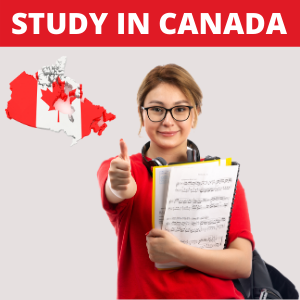Canada Study Permit – Guide to Apply to Study in Canada Easily
Generally, you must apply for a Canada study permit before you come to Canada. Some people can apply for a study permit from within Canada. In some cases, you can apply when you arrive in Canada at the port of entry. Make sure you understand which option is available to you.
Get your documents ready

When you apply, you should submit
- A letter of acceptance from a designated learning institution (DLI) you’ll be attending
- if you’re coming from outside Canada to study as an international student, your letter of acceptance will have to be for a DLI with an approved COVID-19 readiness plan
- As many of the documents needed for a complete application as possible
- We won’t be able to finalize your study permit until you’ve submitted a complete application.
- Waiting to submit documents will cause delays in processing.
- A letter of explanation for any documents that are missing due to COVID-19
If you plan to study in Quebec, you must provide a valid certificate d’acceptation du Québec or proof that you applied for one.
Apply online from outside Canada
Get your study permit faster through the Student Direct Stream
If you’re a legal resident in certain countries, you may be able to get your study permit faster by applying online through the Student Direct Stream.
Step 1: Make sure you have what you need
To apply online, you’ll need:
- A scanner or camera to create electronic copies of your documents, and
- A valid credit or debit card.
Step 2: Read the instruction guide
Even if you apply online, you should read the instruction guide before you complete your application. The guide will explain how to complete each field on the form.
Step 3: Prepare your answers for the online tool
Before you can upload your forms, you must answer some questions. We use your answers to create a personalized document checklist for you.
Step 4: Know the fees you have to pay
In most cases, your fees will include:
- Processing fees for you and anyone you include on your application and
- Biometrics
We’ll ask you to pay your fees at the end of your application.
Third-party fees
Depending on your situation, you may need to pay third parties for:
- Medical exams
- Police certificates
- language testing, and
- Services at a visa application centre if you use one
You won’t pay these fees in your online account. You’ll pay them directly to the third party.
Biometrics fee
In most cases, you should pay a biometrics fee when you submit your application. Otherwise, you may experience delays. The biometrics fee covers the cost of collecting fingerprints and a digital photo.
Step 5: Create your online account or sign in
Try their new online application
They are testing a new online study permit application. It’s now available for some applicants.
Use their new application to apply
You need an account to apply online. You can use your account to:
- Pay your fees
- Submit your application
- Check your status
Apply online from inside Canada
Only some people can apply for a study permit from inside Canada. Do any of the situations below describe you, or the person you’re applying for? (required)
You’re currently in Canada and one of these applies:
- You have a valid study or work permit
- Your spouse, common-law partner or parent has a valid study or work permit
- You’re a minor child in primary or secondary school
- You’re an exchange student or visiting student
- You completed a short-term course or study program required to be accepted at a DLI
- You or your spouse, common-law partner or dependent child has a temporary resident permit (TRP) valid for 6 months or more
- You’re being sponsored to immigrate and you already applied for permanent residence (if you’re eligible)
- You or your spouse, common-law partner or dependent child are subject to an unenforceable removal order
- You’re the spouse, common-law partner or dependent child of:
- an athlete on a team based in Canada
- a member of the media
- a member of the clergy
- military personnel on duty in Canada or
- an accredited foreign representative
- You’re a refugee claimant in Canada or a family member of a refugee claimant in Canada
Step 1: Make sure you have what you need
To apply online, you’ll need:
- A scanner or camera to create electronic copies of your documents, and
- A valid credit or debit card.
Step 2: Read the instruction guide
Even if you apply online, you should read the instruction guide before you complete your application. The guide will explain how to complete each field on the form.
Step 3: Prepare your answers for the online tool
Before you can upload your forms, you must answer some questions. We use your answers to create a personalized document checklist for you.
Step 4: Know the fees you have to pay
In most cases, your fees will include processing fees for you and anyone you include on your application.
We’ll ask you to pay your fees at the end of your application.
COVID-19: Changes to biometrics requirement for in-Canada temporary residence applicants
As a temporary measure, if you’re in Canada and applying to work, study or stay temporarily in Canada, you do not need to give your biometrics.
Step 5: Create your online account or sign in
You need an account to apply online. You can use your account to:
- Pay your fees
- Submit your application
- Check your status
If you can’t apply online
You can submit a paper application if either:
- You can’t apply online because of a disability
- There’s a problem with the online application
Apply at a port of entry
Do any of the following describe you or the person you’re applying for? (required)
You’re a:
- Citizen of the U.S.
- Permanent resident of the U.S.
- Person who has lawfully been admitted to the U.S. for permanent residence
- Resident of Greenland
- Resident of Saint-Pierre and Miquelon
Before you come to Canada
Before you apply for a study permit at a port of entry:
- Answer a few questions to find out if you can travel, or
- Read the travel restrictions and exemptions for international students
If you’re a lawful permanent resident of the United States, and you want to apply at an airport, you must get an electronic travel authorization before you board your flight to Canada.
When you arrive at the port of entry
Tell the officer that you want a study permit. The officer will check
- Your passport or other travel document
- That you meet the eligibility requirements and
- That your medical certificate is valid, if you need one
If you’re eligible for a study permit, the officer will issue one to you. If you’re not eligible, the officer will refuse your study permit. If your permit is refused, you may still be able to enter Canada as a visitor.
Canada Study Permit Processing Time
Your fingerprints and photo (biometrics)
COVID-19: Changes to biometrics requirement
Normally, you need to give biometrics if you haven’t given biometrics in the last 10 years. If your local visa application center is not open due to COVID-19, there are temporary measures in place for biometrics.
They process your study permit application
We’ll check your application to make sure you have all the necessary documents. If it’s incomplete, we may return your application without processing it or request the missing documents.
They may also ask you to:
- Go to an interview with our officials in your country, or
- Send them more information
You may also need to get a:
- Medical exam (if required), or
- Police certificate (if required)
Missing documents
If you weren’t able to submit all the required documents with your application, you can submit the missing documents through your online account or our web form.
We won’t process your study permit until you’ve submitted a complete application. Waiting to submit documents will cause delays in processing.
Updating your application
If you move or change your address, telephone number, or any other contact information after you apply, you must update your application.
If they approve your application
You’ll get your study permit
- At the port of entry when you arrive in Canada or
- Mailed to you, if you’re already in Canada
If you applied for your study permit from outside Canada
We’ll send you a port of entry letter of introduction that says you’re allowed to study in Canada. This letter is not your study permit.
You need to bring this letter with you and show it to a border services officer when you arrive in Canada. We’ll also send you an electronic travel authorization (eTA) or a visitor visa (temporary resident visa) to enter Canada.
If you’re from a country where you need an eTA, the letter of introduction will include information about your eTA. Your eTA will be linked to your passport and is valid for 5 years or until your passport expires, whichever comes first.
It’s important that you travel with the passport you used when you applied for your study permit.
If you’re from a country where you need a visitor visa, the visa will be in your passport. It’ll show if you can enter Canada once or multiple times. You must enter Canada before your visa expires.
If you applied for your study permit from inside Canada
If you were eligible to apply from inside Canada
If you followed the instructions to apply for a study permit from outside Canada
If they refuse your application
They will send you a letter explaining why.
They may refuse your application if you didn’t
- Show proof that you have enough money to support yourself while studying in Canada
- Pass your medical exam, if you needed to get one
- Convince the visa officer that your main purpose in Canada is to study or
- Convince the visa officer that you’ll leave Canada at the end of your study period
If you have questions about why you were refused, contact the visa office that sent you the refusal letter.
Before you come to Canada
Make sure you’re eligible to travel to Canada at this time if
- You want to come to Canada to study
- You’re returning to Canada as an international student, or
- You’re coming to Canada as a family member or support person for an international student
You need to use ArriveCAN
Use ArriveCAN to provide mandatory travel information required for entry into Canada.
Make sure you’re using the newest version of ArriveCAN. If you previously submitted your information using an older version of ArriveCan, you must download the latest version and resubmit your information.
When you arrive in Canada
When you arrive in Canada, you’ll meet a border services officer who will make sure you meet some basic requirements. To enter Canada, you must
- Have a valid travel document, such as a passport
- Have the port of entry letter of introduction the visa office sent you when they approved your study permit
- This letter has your permit reference number, which we use to issue your study permit.
- Have a copy of a valid letter of acceptance from your school
- Have letters of reference or any other documents the visa office told you to bring
- Have either a valid electronic travel authorization (eTA) or a visitor visa (temporary resident visa)
- If you have a valid eTA, it’ll be linked to the passport you used to apply for your study permit.
- Have enough money for your stay (the amount you will need can vary—it depends on things such as how long you will stay, and whether you will stay in a hotel, or with friends or relatives)
- Ce in good health
- Have no criminal or immigration-related convictions
- Convince an immigration officer that
- you have ties—such as a job, home, financial assets or family—that will take you back to your home country
- you will leave Canada at the end of your visit
- have valid immigration medical exam results (if you needed one)
- Your exam is valid for 12 months from the day you get it.
- It must be valid the day you enter Canada.
- If your exam will expire before you enter Canada, you need to get another medical exam.
- This applies even if your letter of introduction is still valid.
- prove that you’ll leave Canada at the end of your stay
Fully vaccinated travellers
If you qualify as a fully vaccinated traveler, you must bring proof with you when you come to Canada. The border services officer will make the final decision about whether you qualify as a fully vaccinated traveler, so you still have to be prepared to follow the COVID-19 quarantine and testing requirements.
If you need proof you entered Canada
Your school or training facility may need you to prove you entered Canada. If you need proof of entry, make sure a border services officer stamps your passport before you leave Canadian customs. You may also be able to use a Primary Inspection Kiosk to stamp your passport.
Inadmissibility
Some people are inadmissible—they’re not allowed to come to Canada. Several things can make you inadmissible, including involvement in criminal activity, human rights violations, or in organized crime.
You can also be inadmissible for security, health, or financial reasons.






